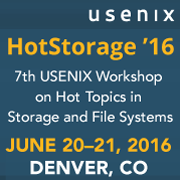sponsors
help promote

usenix conference policies
On the Non-Suitability of Non-Volatility
Error message
You are not authorized to post comments.John Bent, EMC Corporation; Brad Settlemyer and Nathan DeBardeleben, Los Alamos National Laboratory; Sorin Faibish, Uday Gupta, Dennis Ting, and Percy Tzelnic, EMC Corporation
For many emerging and existing architectures, NAND flash is the storage media used to fill the cost-performance gap between DRAM and spinning disk. However, while NAND flash is the best of the available options, for many workloads its specific design choices and trade-offs are not wholly suitable. One such workload is long-running scientific applications which use checkpoint-restart for failure recovery. For these workloads, HPC data centers are deploying NAND flash as a storage acceleration tier, commonly called burst buffers, to provide high levels of write bandwidth for checkpoint storage. In this paper, we compare the costs of adding reliability to such a layer versus the benefits of not doing so. We find that, even though NAND flash is non-volatile, HPC burst buffers should not be reliable when the performance overhead of adding reliability is greater than 2%.
Open Access Media
USENIX is committed to Open Access to the research presented at our events. Papers and proceedings are freely available to everyone once the event begins. Any video, audio, and/or slides that are posted after the event are also free and open to everyone. Support USENIX and our commitment to Open Access.
author = {John Bent and Brad Settlemyer and Nathan DeBardeleben and Sorin Faibish and Dennis Ting and Uday Gupta and Percy Tzelnic},
title = {On the {Non-Suitability} of {Non-Volatility}},
booktitle = {7th USENIX Workshop on Hot Topics in Storage and File Systems (HotStorage 15)},
year = {2015},
address = {Santa Clara, CA},
url = {https://www.usenix.org/conference/hotstorage15/workshop-program/presentation/bent},
publisher = {USENIX Association},
month = jul
}















connect with us